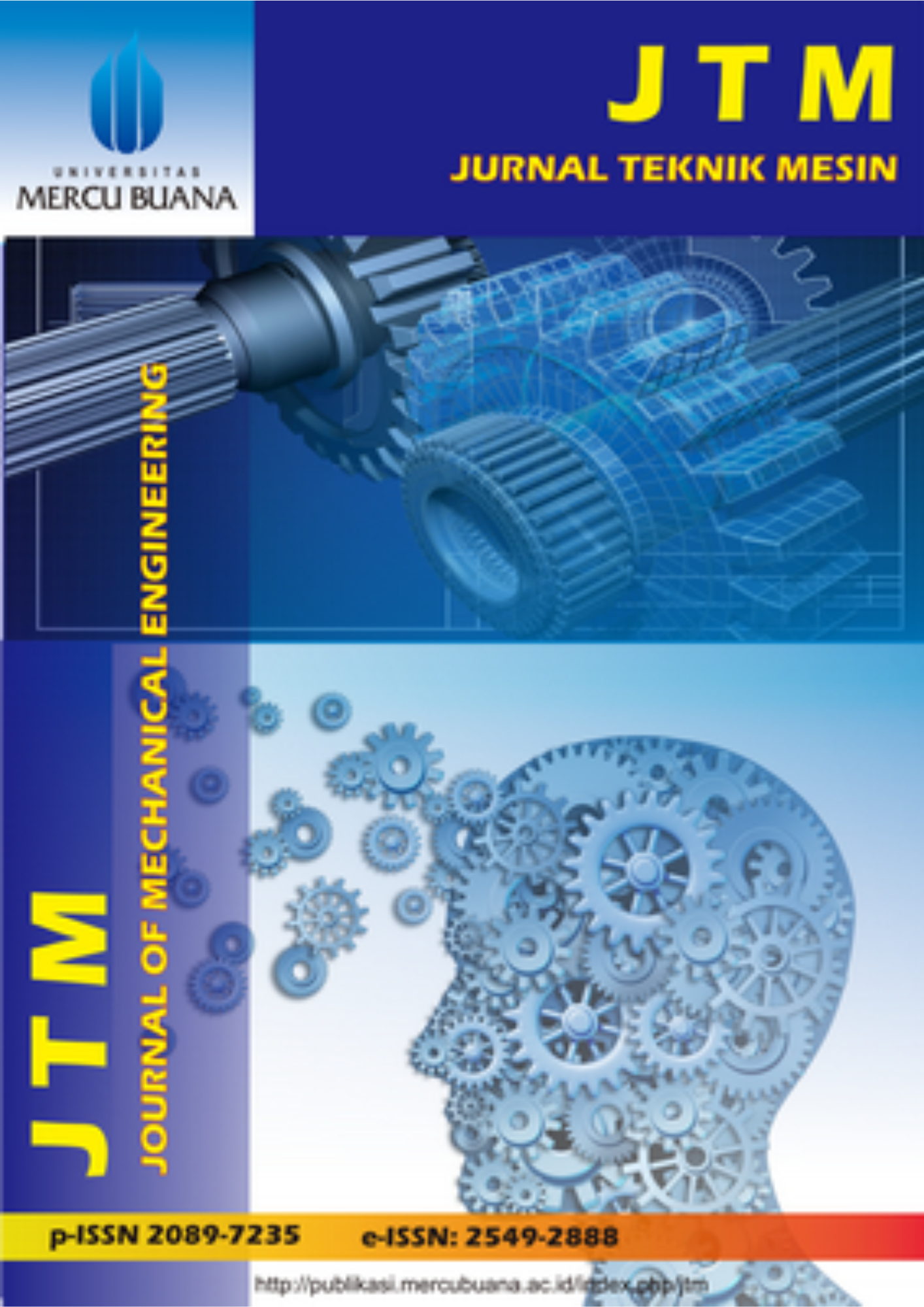Finite Element Analysis and Optimization of Medium Bus Frame Structure
Abstract
Keywords
Full Text:
PDFReferences
Z. Yang, B. Deng, M. Deng, and G. Sun, “A Study on Finite Element Analysis of Electric Bus Frame for Lightweight Design,” MATEC Web Conf., vol. 175, p. 03049, 2018, doi: 10.1051/matecconf/201817503049.
M. Abbasi, “Study of Electric Buses and Their Impact on the Environment in Urban Networks Study of Electric Buses and Their Impact on The Environment in Urban Networks SeyedMostafa JafarzadehFadaki SeyyedReza Esmaeilzadeh,” no. February 2018, 2019.
I. Haryanto, A. Raharjo, O. Kurdi, G. D. Haryadi, S. P. Santosa, and L. Gunawan, “Optimization of Bus Body Frame Structure for Weight Minimizing with Constraint of Natural Frequency using Adaptive Single-Objective Method,” Int. J. Sustain. Transp. Technol., vol. 1, no. 1, pp. 9–14, 2018.
Y. Wang et al., “Fuel consumption and emission performance from light-duty conventional/hybrid-electric vehicles over different cycles and real driving tests,” Fuel, vol. 278, p. 118340, 2020, doi: https://doi.org/10.1016/j.fuel.2020.118340.
Y. Huang, N. C. Surawski, B. Organ, J. L. Zhou, O. H. H. Tang, and E. F. C. Chan, “Fuel consumption and emissions performance under real driving: Comparison between hybrid and conventional vehicles,” Sci. Total Environ., vol. 659, pp. 275–282, 2019, doi: https://doi.org/10.1016/j.scitotenv.2018.12.349.
T. Wu, X. Han, M. M. Zheng, X. Ou, H. Sun, and X. Zhang, “Impact factors of the real-world fuel consumption rate of light duty vehicles in China,” Energy, vol. 190, p. 116388, 2020, doi: https://doi.org/10.1016/j.energy.2019.116388.
H. S. Chong, S. Kwon, Y. Lim, and J. Lee, “Real-world fuel consumption, gaseous pollutants, and CO2 emission of light-duty diesel vehicles,” Sustain. Cities Soc., vol. 53, p. 101925, 2020, doi: https://doi.org/10.1016/j.scs.2019.101925.
F. Del Pero, M. Delogu, and M. Pierini, “The effect of lightweighting in automotive LCA perspective: Estimation of mass-induced fuel consumption reduction for gasoline turbocharged vehicles,” J. Clean. Prod., vol. 154, pp. 566–577, 2017, doi: https://doi.org/10.1016/j.jclepro.2017.04.013.
J. Sawulski and M. Ławryńczuk, “Optimization of control strategy for a low fuel consumption vehicle engine,” Inf. Sci. (Ny)., vol. 493, pp. 192–216, 2019, doi: https://doi.org/10.1016/j.ins.2019.04.047.
O. Kurdi, R. A. Rahman, and P. M. Samin, “Optimization of heavy duty truck chassis design by considering torsional stiffness and mass of the structure,” Appl. Mech. Mater., vol. 554, no. August 2015, pp. 459–463, 2014, doi: 10.4028/www.scientific.net/AMM.554.459.
C. WANG et al., “Multi-scale design and optimization for solid-lattice hybrid structures and their application to aerospace vehicle components,” Chinese J. Aeronaut., 2020, doi: https://doi.org/10.1016/j.cja.2020.08.015.
O. Kurdi et al., “Design and fabrication of a twist fixture to measure torsional stiffness of a pick up chassis,” in MATEC Web of Conferences, 2018, vol. 159, doi: 10.1051/matecconf/201815902030.
O. Kurdi, M. S. Yob, S. R. Dasson, S. Barrathi, A. A. Altayeb, and I. Yulianti, “Stress Reduction of Pickup Truck Chassis Using Finite Element Method,” in Journal of Physics: Conference Series, 2017, vol. 824, no. 1, doi: 10.1088/1742-6596/824/1/012001.
O. Kurdi, R. Abd-Rahman, and M. N. Tamin, “Stress analysis of heavy duty truck chassis usig finite element method,” J. Mech., no. 26, pp. 76–85, 2008.
O. Kurdi, R. A. Rahman, P. M. Samin, M. S. Yob, N. K. Nadarajan, and I. Yulianti, “Torsional Stiffness Improvement of Truck Chassis Using Finite Elemen Method,” Rotasi, vol. 19, no. 2, p. 76, 2017, doi: 10.14710/rotasi.19.2.76-81.
G. D. Gautam, K. P. Singh, A. Prajapati, and G. Norkey, “Design optimization of roll cage for formula one vehicle by using finite element analysis,” Mater. Today Proc., vol. 28, pp. 2068–2076, 2020, doi: https://doi.org/10.1016/j.matpr.2020.03.052.
Y. Ren, Y. Yu, B. Zhao, C. Fan, and H. Li, “Finite Element Analysis and Optimal Design for the Frame of SX360 Dump Trucks,” Procedia Eng., vol. 174, pp. 638–647, 2017, doi: https://doi.org/10.1016/j.proeng.2017.01.201.
E. V Arcieri, S. Baragetti, M. Fustinoni, S. Lanzini, and R. Papalia, “Study and modelling of the passenger safety devices of an electric vehicle by finite elements,” Procedia Struct. Integr., vol. 8, pp. 212–219, 2018, doi: https://doi.org/10.1016/j.prostr.2017.12.023.
S. Li and X. Feng, “Study of structural optimization design on a certain vehicle body-in-white based on static performance and modal analysis,” Mech. Syst. Signal Process., vol. 135, p. 106405, 2020, doi: https://doi.org/10.1016/j.ymssp.2019.106405.
W. Wang, C. Zhou, C. Lin, and J. Chen, “Electric Bus Body Lightweight Design Based on Multiple Constrains,” Adv. Mater. Res., vol. 538–541, pp. 3137–3144, Jun. 2012, doi: 10.4028/www.scientific.net/AMR.538-541.3137.
B. R. Miao, Y. X. Luo, Q. M. Peng, Y. Z. Qiu, H. Chen, and Z. K. Yang, “Multidisciplinary design optimization of lightweight carbody for fatigue assessment,” Mater. Des., vol. 194, p. 108910, 2020, doi: https://doi.org/10.1016/j.matdes.2020.108910.
A. T. Corviniensis, E. T. Vii, and G. Belingardi, “Lighweight Design of Vehicle Body A Contribution Toward,” 2014.
NEPTECH, “Reducing the Weight of a Bus Body Frame by 17 % Without Compromise to Performance or Safety,” Altair, Prod.
A. H. Kumar and V. Deepanjali, “Design & Analysis of Automobile Chassis,” Int. J. Eng. Innov. Technol., vol. 5, no. 1, pp. 187–196, 2016.
S. Razak, M. Hasim, and N. A. Ngatiman, “Design of Electric Vehicle Racing Car Chassis using Topology Optimization Method,” MATEC Web Conf., vol. 97, p. 1117, Jan. 2017, doi: 10.1051/matecconf/20179701117.
S. Nandhakumar, S. Seenivasan, A. Mohammed Saalih, and M. Saifudheen, “Weight optimization and structural analysis of an electric bus chassis frame,” Mater. Today Proc., 2020, doi: https://doi.org/10.1016/j.matpr.2020.07.404.
L. V. Campo, A. Ledezma, and J. C. Corrales, “Optimization of coverage mission for lightweight unmanned aerial vehicles applied in crop data acquisition,” Expert Syst. Appl., vol. 149, p. 113227, 2020, doi: https://doi.org/10.1016/j.eswa.2020.113227.
DOI: http://dx.doi.org/10.22441/jtm.v14i2.33587
Refbacks
- There are currently no refbacks.
Copyright (c) 2025 Jurnal Teknik Mesin (Journal Of Mechanical Engineering)
Jurnal Teknik Mesin (JTM)
Program Studi Teknik Mesin, Fakultas Teknik, Universitas Mercu Buana
Jl. Meruya Selatan No. 01, Kembangan, Jakarta Barat 11650, Indonesia
Email: [email protected]
Telp.: 021-5840815/ 021-5840816 (Hunting)
Fax.: 021-5871335
JTM is indexed by the following abstracting and indexing services:

This work is licensed under a Creative Commons Attribution-NonCommercial 4.0 International License.






.png)







_(486_x_90_px)_(486_x_190_px)_(486_x_190_px)_(4).png)
_(486_x_90_px)_(486_x_190_px)_(486_x_190_px)_(5).png)
2.png)
.png)